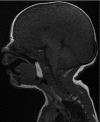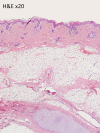A hairy situation
- PMID: 26055604
- PMCID: PMC4460391
- DOI: 10.1136/bcr-2015-209825
A hairy situation
Abstract
A 2-day-old neonate was transferred to a specialist paediatric otolaryngology centre with stridor at rest, feeding difficulties and an apparent mass in the oropharynx. The newborn displayed evidence of respiratory distress, however, she remained self-ventilating. MRI highlighted a fat-containing lesion in the postnasal space with no intracranial extension. A CT scan under general anaesthesia showed no underlying bony abnormality, and hence an examination of the nasopharynx, oropharynx and microlaryngoscopy and bronchoscopy were performed. The macroscopically hairy lesion arising from the superior aspect of the soft palate was resected. Histology displayed a benign growth measuring 28×17×12 mm in keeping with a hairy polyp. This is one of very few cases, to the best of our knowledge, in which a hairy polyp (bigerminal choristomas) has resulted in stridor in the first few days of life. Nasal masses in neonates, although a rare phenomenon, remain clinically important as they are obligate nasal breathers.
2015 BMJ Publishing Group Ltd.
Figures






References
-
- Brown-Kelly A. Hairy or dermoid polyp of the pharynx and nasopharynx. J Laryngol Otol 1918;33:65–70. 10.1017/S1755146300018114 - DOI
Publication types
MeSH terms
LinkOut - more resources
Full Text Sources
Other Literature Sources
